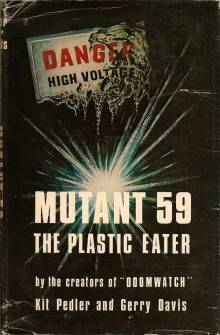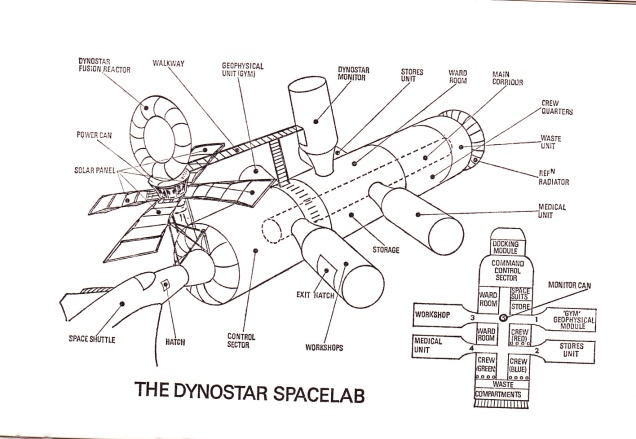
The Apollo 19 space mission explodes as it re-enters the earth’s atmosphere. BEA flight 510 crashes into a suburban street on its approach to Heathrow with devastating results. A computerised traffic system fails, bringing chaos to central London. A nuclear submarine, HMS Triton, sinks with the loss of all hands. This is the dramatic opening of Mutant 59:the Plastic Eater, a novel written by the scientist Kit Pedler and the television writer and producer, Gerry Davis, and published in 1972.
The two men met in 1966 when Gerry was the script editor at Doctor Who, and was looking for a scientific advisor to inject a greater degree of scientific speculation into the programme. Kit was head of a research unit at the Institute of Opthamalmology at the University of London which was investigating how the eye worked, using an electron microscope, and whether it might be possible to devise a camera which could restore sight to the blind. A doctor by training, Kit read widely, and had a zest for explaining science topics to a wider public. (He also read science fiction). Kit came to the attention of the BBC after Tomorrow’s World visited his unit, and was then invited to meet Gerry. Straightaway they formed a close working relationship.
Kit suggested that the newly built Post Office Tower, then the tallest structure in London, could be used by a computer to take over the capital using the telephone network to control the minds of humans. This evolved into the serial The War Machines, broadcast in the summer of 1966, featuring the computer WOTAN and its war machines. They then came up with the idea of the Cybermen: humanoids who have replaced so much of their bodies with technology that they have lost all emotion and empathy. Their first story featuring the Cybermen “The Tenth Planet” aired in the autumn 1966. The silver monsters were a big hit with the public, and were quickly brought back in “The Moonbase” (February 1967) and then in “The Tomb of the Cybermen” (September 1967). After Gerry left Doctor Who Kit worked with Victor Pemberton on “The Wheel in Space” (May 1968), and with Derrick Sherwin on another Cybermen serial “The Invasion” (November 1968). This was Kit’s last involvement with Doctor Who.
 By 1970 Kit was becoming disillusioned by science and increasingly alarmed about the effect that technology and the headlong rush for economic growth at all costs was having on the environment. He, and many others around the globe, feared the possibility of ecological collapse. Working together again, Kit and Gerry created a series for the BBC called Doomwatch. “Doomwatch” is the nickname for special government unit established to monitor environmental and other threats to the public. The first series created a sensation with storylines on issues such as transplants, genetic mutation of rats, melting plastic, chemical poisoning, and a crashed and armed nuclear bomb on the south coast. The extensive scientific research done by Kit for the series meant that the storylines appeared to anticipate news stories, and he soon became a public figure, frequently appearing on television and the radio to comment on environmental and other scientific matters. However, Kit and Gerry disagreed with the direction that the producer , Terence Dudley, was taking Doomwatch and left after the second series. The third and final series had little impact.
By 1970 Kit was becoming disillusioned by science and increasingly alarmed about the effect that technology and the headlong rush for economic growth at all costs was having on the environment. He, and many others around the globe, feared the possibility of ecological collapse. Working together again, Kit and Gerry created a series for the BBC called Doomwatch. “Doomwatch” is the nickname for special government unit established to monitor environmental and other threats to the public. The first series created a sensation with storylines on issues such as transplants, genetic mutation of rats, melting plastic, chemical poisoning, and a crashed and armed nuclear bomb on the south coast. The extensive scientific research done by Kit for the series meant that the storylines appeared to anticipate news stories, and he soon became a public figure, frequently appearing on television and the radio to comment on environmental and other scientific matters. However, Kit and Gerry disagreed with the direction that the producer , Terence Dudley, was taking Doomwatch and left after the second series. The third and final series had little impact.
Kit and Gerry continued their working relationship in a series of novels published in the early 1970s, the first of which was Mutant 59. This was inspired by the first Doomwatch episode “The Plastic Eater”, but was not a novelisation: instead it was a complete re-imagining by Kit and Gerry of their original concept. The central character is Luke Gerrard, a doctor working for a chemical company run by the scientist Arnold Kramer which has pioneered a plastic for bottles, Degron, which disintegrates after use.
Luke investigates what is happening to plastic components which appear to be failing. He is sent to to look at a robot that runs amok in a toy shop, and then at melting cables in a Tube tunnel, along with a journalist, Anne Kramer, wife of the magnate. Whilst they are down there there are series of catastrophic explosions in the underground which bring the centre of London to a halt. These are caused, we eventually learn, by Degron combining with a plastic eating virus, Mutant 59, which has accidentally been released into the sewer system.
The result is a virus which melts plastic, gives off gas, and spreads rapidly. The central part of the novel describes Luke and Anne’s exhausting trek to escape from the underground, and the desperate efforts of the government to stop the infection, which include imposing a military cordon that seals off much of central London. In the final part of the novel Arnold Kramer takes the infection onto a trans-Atlantic jet airliner which horrifically melts around the crew and passengers in mid-flight, while Luke succeeeds in finding an antidote to the virus at the eleventh hour (as they always do in such novels).
This is a slickly written thriller, drive by incident rather than character, which reflects Gerry’s skill as a writer. Kit’s contribution is the credible scientific background on the creation of the virus and its role in breaking down systems, including in Chapter 8 a detailed account of how the melting plastic would impact on the sub-structure of London.
Down in the gas-filled Samson line tunnel two copper cables finally lay bare. One was above the other on the wall of the tunnel and slowly sagged towards its fellow. the upper carried 170 volts of electricity and the lower was at earth potential. They touched. There was a small spark and power abruptly drained away.
In the Coburg Street control room, a duty engineer raised puzzled eyebrows at an unfamiliar light signal in front of him. In the tunnel came the first explosion as the trapped gas ignited. It occurred in the space between two northbound trains and so was confined to the cylindrical space of air between them. A racing wall of flame slammed into the rear of the train ahead and shattered the window of the driver’s cab in the train behind.
As the force of the explosion reached its maximum, the bolted-concrete segments of the tunnel split, carrying with them the mass of steel plates and concrete which held the overhead Metropolitan line tunnel from collapse. One of the two twenty-four inch gas mains embedded in the concrete of the roof support sheared open releasing a flood of town gas into the shattered tunnel….Finally, the the mixture of tunnel gas reached its optimim concentration and exploded…At that moment, deep below, Gerrard and the others were thrown to the floor of the tunnel.
On the surface, the road slowly bulged upwards, split, and flung out like a slow-motion mud bubble, bursting into a ball of orange and yellow flame which shot skywards like a small nuclear explosion. Shock waves ballooned out into the fog, sweeping it aside in curved veils of force which flashed through the tightly packed lines of traffic.
As a character Anne Kramer seems to have been introduced principally as the sex interest in the novel. “She was a beautiful woman by any standards. Tall with thick dark-brown hair, large fine hazel eyes, and a slightly olive complexion…She could certainly handle men.” Luke Gerrard is strongly attracted to her, particularly when she strips to her undies to dry her clothes by a fire when they are trapped underground. They get together, of course. All very 1970s.
One of the themes of the novel is how the pursuit of profit corrupts science. Luke went to work for Arnold Kramer because he believed in him, but Kramer changed when the money started rolling in. “Every remark, every concept, every speculation was now directed towards the profit motive…does it, or does it not, make money!” With her husband perishing in the air crash, Anne successfuly schemes to place Luke in charge of the company. He offers a new vision:”None of us set out to do anything more than be technically ingenious. We succeeded and London nearly died. ..the next time it may be the whole world…we can surely find ways of being creative on behalf of society.”
The novel ends ominously with a unmanned probe from Earth, Argonaut One, landing on Mars. “Two hours after sunrise the following morning, Argonaut One died abruptly. Inside its shiny body, plastic began to soften…”
Further reading
You can read an interview with Kit and Gerry from 1973 about the novel which I have posted here.
Michael Seely has produced an excellent biography of Kit Pedler: The Quest for Pedler:the Life and Times of Dr Kit Pedler (2014), published by miwk.
You can watch one episode from Mind Over Matter, a television series presented by Kit in the spring in 1981, which looked at the possibility of telepathy and other paranormal activity being scientifically possible.
If you would like to comment on this post, you can either comment via the blog or email me, fopsfblog@gmail.



 problems of one of Britain’s most grotesque city environments.
problems of one of Britain’s most grotesque city environments.
 By 1970 Kit was becoming disillusioned by science and increasingly alarmed about the effect that technology and the headlong rush for economic growth at all costs was having on the environment. He, and many others around the globe, feared the possibility of ecological collapse. Working together again, Kit and Gerry created a series for the BBC called
By 1970 Kit was becoming disillusioned by science and increasingly alarmed about the effect that technology and the headlong rush for economic growth at all costs was having on the environment. He, and many others around the globe, feared the possibility of ecological collapse. Working together again, Kit and Gerry created a series for the BBC called